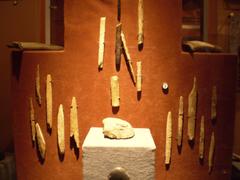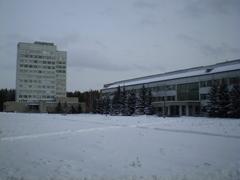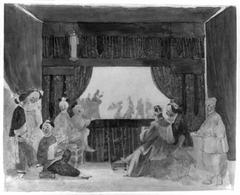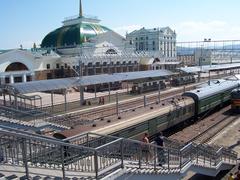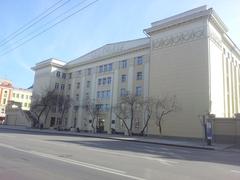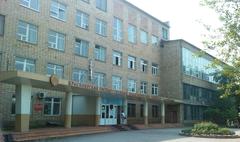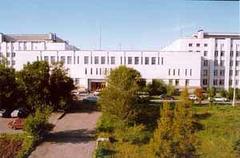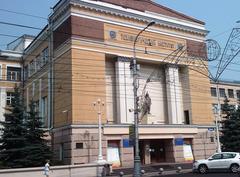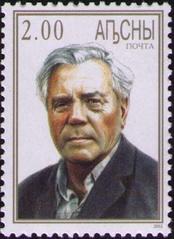Transfiguration Church Krasnoyarsk: Visiting Hours, Tickets, and Historical Significance
Date: 04/07/2025
Introduction
The Transfiguration Church in Krasnoyarsk, Russia, stands as a striking neo-Gothic landmark and an enduring symbol of the city’s rich cultural and religious tapestry. Founded in the 19th century to serve the growing Catholic community—primarily Polish exiles—it offers visitors a rare window into the spiritual resilience and architectural heritage of Siberia. Today, the church functions both as an active place of worship and as a vibrant cultural site, welcoming travelers, history enthusiasts, and the faithful alike. This guide details the church’s origins, architectural features, visiting hours, ticket information, accessibility, nearby attractions, and practical travel advice to help you make the most of your visit (Wikipedia; Diocese of Irkutsk Official Site; Heroes of Adventure).
Table of Contents
- Historical Overview
- Architectural and Artistic Value
- Visiting Information: Hours, Tickets, and Accessibility
- Visitor Experience and Etiquette
- Nearby Attractions and Travel Tips
- Frequently Asked Questions (FAQ)
- Visuals and Media
- Summary and Final Thoughts
- References
Historical Overview
Catholic Roots in Siberia
The roots of the Transfiguration Church are deeply entwined with the arrival of Catholic exiles—especially Poles, Lithuanians, and Germans—during the 19th century. The Krasnoyarsk Catholic parish was officially established in 1836, initially under the Archdiocese of Mogilev and St. Petersburg, reflecting the centralized nature of Catholic administration in the Russian Empire (Wikipedia).
First Church Building and Community Growth
In 1855, imperial authorities granted approval for the construction of a Catholic church. The first structure, completed in 1857, was a wooden, neo-Gothic edifice, notable for its rarity in Siberia at the time. Adorned with stucco and whitewashed walls, it became a hub for Catholics seeking to preserve their faith and cultural identity (Wikipedia).
Neo-Gothic Transformation
By the early 20th century, the growing Catholic population necessitated a larger building. From 1908 to 1910, the current brick church was constructed at 20 Dekabristov Street. Designed in the neo-Gothic style, with pointed arches, ribbed vaults, and stained-glass windows, the church remains a rare example of this architectural tradition in Siberia (Wikipedia).
Soviet Era and Revival
Following the 1917 Revolution, religious activity was suppressed. The church was repurposed as an organ hall for the local Philharmonic in 1982, mirroring the fate of many religious buildings during Soviet times. Catholic services resumed in 1993 after restrictions eased, and the church today is again a focal point for the Catholic community, operating under the Diocese of Irkutsk (Diocese of Irkutsk Official Site).
Architectural and Artistic Value
Exterior Features
The Transfiguration Church’s red brick façade, high lancet windows, and pointed arches set it apart from the city’s predominantly Orthodox and Baroque religious structures. Decorative details such as ornate brickwork, pilasters, and an imposing bell tower reflect both European influences and local craftsmanship (Orangesmile.com).
Interior Highlights
Inside, the church features a spacious nave, a majestic iconostasis, and vibrant frescoes. The sanctuary’s high vaulted ceilings enhance the sense of verticality and light. The church’s association with sacred music continues, with an organ (originally the “Melodikon”) central to both liturgical and concert events.
Restoration and Preservation
Ongoing restoration efforts ensure the preservation of architectural and artistic features. Traditional materials and methods are employed to maintain authenticity, with careful attention to frescoes, iconography, and structural details (EAA: Church of the Transfiguration, Kizhi).
Visiting Information: Hours, Tickets, and Accessibility
- Location: 20 Dekabristov Street, central Krasnoyarsk
- Visiting Hours: Generally open daily from 8:00 AM to 7:00 PM; hours may extend during major religious festivals.
- Tickets: Admission is free; donations are appreciated. Tickets may be required for concerts or special events.
- Guided Tours: Available upon request through the parish office or local tour operators (in Russian and sometimes English).
- Accessibility: Wheelchair ramps and accessible restrooms are available. Some interior areas may have limited access; contact the parish in advance for assistance (Miss Tourist).
Visitor Experience and Etiquette
Dress Code and Conduct
- Modest attire is expected: men should remove hats, women are encouraged to cover their heads.
- Shoulders and knees should be covered.
- Silence and respectful behavior are required, especially during services.
- Photography is allowed outside; interior photography is restricted during services and in certain areas—always check posted signs.
Liturgical Life and Events
- Daily liturgies, vespers, and special feast day celebrations are open to visitors.
- The church also hosts concerts and community events—check notice boards or contact staff for schedules.
Facilities
- Restrooms are limited on-site; nearby cafes and shopping centers may offer facilities.
- Small kiosks sometimes sell candles and religious souvenirs.
Nearby Attractions and Travel Tips
- Revolution Square: A historic urban space for public gatherings.
- Krasnoyarsk Music Theatre: Offers performances and concerts.
- Paraskeva Pyatnitsa Chapel: Famous for panoramic city views.
- Yenisei River Embankment: Ideal for scenic walks.
- Stolby Nature Reserve: For nature enthusiasts and hikers.
Travel Tips:
- Use public transport or taxis for easy access.
- Best visiting times are early mornings or late afternoons on weekdays.
- Dress warmly for winter visits; summers are mild and pleasant.
- The city’s Tourist Information Center offers maps and English assistance (Miss Tourist).
Frequently Asked Questions (FAQ)
Q: What are the visiting hours?
A: Daily from 8:00 AM to 7:00 PM. Hours may extend during religious festivals.
Q: Is there an admission fee?
A: No, entry is free; donations are welcome.
Q: Are guided tours available?
A: Yes, by request through the parish or local tour operators (often in Russian; some English tours available).
Q: Is the church wheelchair accessible?
A: Yes, ramps and accessible restrooms are available, but some areas may be challenging for wheelchair users.
Q: Is photography allowed?
A: Exterior photography is permitted. Interior photography is restricted, especially during services.
Q: What is the best time to visit?
A: Weekdays outside major Orthodox holidays are less crowded; summer offers pleasant weather.
Visuals and Media
- Images and virtual tours are available on the official Krasnoyarsk tourism portal.
- Use alt text such as “Transfiguration Church Krasnoyarsk exterior” and “Interior frescoes of Transfiguration Church Krasnoyarsk” for accessibility and SEO (Miss Tourist).
Summary and Final Thoughts
The Transfiguration Church is a cornerstone of Krasnoyarsk’s multicultural heritage. Its neo-Gothic architecture, historical resilience, and active liturgical life make it a must-visit destination for those interested in Russian religious history, architecture, or cultural life. With its central location, free admission, and proximity to other major attractions, the church is ideal for both independent travelers and guided tours. Respect local customs, plan your visit around services or special events, and immerse yourself in this unique Siberian treasure (Wikipedia; Orangesmile.com; Miss Tourist).
References
- Wikipedia: Transfiguration Church, Krasnoyarsk
- Diocese of Irkutsk Official Site
- Orangesmile.com: Krasnoyarsk Cultural Guide
- Heroes of Adventure: Catholic Cathedral of the Transfiguration
- Miss Tourist: Krasnoyarsk Itinerary & Travel Tips
For more travel tips and updates, download the Audiala app and follow us on social media for the latest on Krasnoyarsk’s historical and cultural sites.
